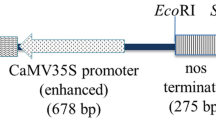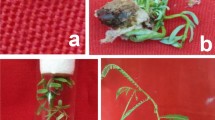Abstract
In spite of the economic importance of sesame (Sesamum indicum L.) and the recent availability of its genome sequence, a high-frequency transformation protocol is still not available. The only two existing Agrobacterium-mediated transformation protocols that are available have poor transformation efficiencies of less than 2 %. In the present study, we report a high-frequency, simple, and reproducible transformation protocol for sesame. Transformation was done using de-embryonated cotyledons via somatic embryogenic stages. All the critical parameters of transformation, like incubation period of explants in pre-regeneration medium prior to infection by Agrobacterium tumefaciens, cocultivation period, concentrations of acetosyringone in cocultivation medium, kanamycin concentration, and concentration of plant hormones, including 6-benzylaminopurine, have been optimized. This protocol is superior to the two existing protocols in its high regeneration and transformation efficiencies. The transformed sesame lines have been tested by PCR, RT-PCR for neomycin phosphotransferase II gene expression, and β-glucuronidase (GUS) assay. The regeneration frequency and transformation efficiency are 57.33 and 42.66 %, respectively. T0 and T1 generation transgenic plants were analyzed, and several T1 plants homozygous for the transgenes were obtained.









Similar content being viewed by others
Abbreviations
- BAP:
-
6-Benzylaminopurine
- IAA:
-
Indole-3-acetic acid
- ABA:
-
Abscisic acid
- Kan:
-
Kanamycin
- GUS:
-
β-Glucuronidase
- MS:
-
Murashige and Skoog
References
Aggarwal D, Kumar A, Reddy MS (2011) Agrobacterium tumefaciens mediated genetic transformation of selected elite clone(s) of Eucalyptus tereticornis. Acta Physiol Plant 33:1603–1611
Al-Shafeay AF, Ibrahim AS, Nesiem MR, Tawfik MS (2011) Establishment of regeneration and transformation system in Egyptian sesame (Sesamum indicum L.) cv Sohag1. GM Crops 2:182–192
Alvarez JM, Ordas MJ (2013) Stable Agrobacterium-mediated transformation of maritime pine based on kanamycin selection. The Scientific World J. doi:10.1155/2013/681792
Banerjee A, Chattopadhyay S (2009) Genetic transformation of a hepatoprotective plant, Phyllanthus amarus. In Vitro Cell Dev Bio Plant 45:57–64
Bhaskaran P, Jayabalan N (2006) In vitro mass propagation and diverse callus orientation on Sesamum indicum L.—an important oil plant. J Agric Tech 2:259–269
Bhatnagar S, Khurana P (2003) Agrobacterium tumefaciens-mediated transformation of Indian mulberry, Morus indica cv. K2: a time-phased screening strategy. Plant Cell Rep 21:669–675
Chattopadhyaya B, Banerjee J, Basu A, Sen SK, Maiti MK (2010) Shoot induction and regeneration using internodal transverse thin cell layer culture in Sesamum indicum L. Plant Biotechnol Rep 4:173–178
Chowdhury S, Basu A, Ray Chaudhuri T, Kundu S (2014) In-vitro characterization of the behaviour of Macrophomina phaseolina (Tassi) Goid at the rhizosphere and during early infection of roots of resistant and susceptible varieties of sesame. Eur J Plant Pathol 138:361–375
Doyle JJ, Doyle JL (1987) A rapid DNA isolation procedure for small quantities of fresh leaf tissue. Phytochemistry Bull 19:11–15
Enikuomehin OA, Jimoh M, Olowe VIO, John E, Ayo I, Akintokun PO (2011) Effect of sesame (Sesamum indicum L.) population density in a sesame/maize (Zea mays L.) intercrop on the incidence and severity of foliar diseases of sesame. Arch Phytopath Plant Protect 44(2):168–178
George L, Bapat VA, Rao PS (1987) In vitro multiplication of sesame (Sesamum indicum L.) through tissue culture. Ann Bot 60:17–21
Hu Z, Wu YR, Li W, Gao H (2006) Factors affecting Agrobacterium tumefaciens mediated genetic transformation of Lycium barbarum L. In Vitro Cell Dev Bio Plant 42:461–466
Jefferson RA, Kavanagh TA, Bevan MW (1987) Gus fusions-glucoronidase as a sensitive and versatile gene fusion marker in higher plants. EMBO J 6:3901–3907
Mandal S, Mandal RK (2000) Seed storage proteins and approaches for improvement of their nutritional quality by genetic engineering. Curr Sci 79:576–589
Mandal S, Kundu P, Roy B, Mandal RK (2002) Precursor of the inactive 2S seed storage protein from the Indian mustard Brassica juncea is a novel trypsin inhibitor: characterization, post-translational processing studies and transgenic expression to develop insect resistant plants. J Biol Chem 277:37161–37168
Mao J, Cao LY, Kong LF, Jongsma MA, Wang CY (2013) An Agrobacterium-mediated transformation system of pyrethrum (Tanacetum cinerariifolium) based on leaf explants. Sci Hort 150:130–134
Mary RJ, Jayabalan N (1997) Influence of growth regulators on somatic embryogenesis in sesame. Plant Cell Tissue Organ Cult 49:67–70
Mehrotra M, Sanyal I, Amla DV (2011) High-efficiency Agrobacterium-mediated transformation of chickpea (Cicer arietinum L.) and regeneration of insect resistant transgenic plants. Plant Cell Rep 30:1603–1616
Murashige T, Skoog F (1962) A revised medium for rapid growth and bioassays with tobacco tissue cultures. Physiol Plant 15:473–497
Pei X, Li S, Jiang Y, Zhang Y, Wang Z, Jia S (2007) Isolation, characterization and phylogenetic analysis of the resistance gene analogues (RGAs) in banana (Musa spp.). Plant Sci 172:1166–1174
Ram R, Catlin D, Romero J, Cowley C (1990) Sesame: new approaches for crop improvement. In: Janick J, Simon JE (eds) Advances in new crops. Timber Press, Portland, pp 225–228
Sahoo KK, Tripathi AK, Pareek A, Sopory SK, Singla-Pareek SL (2011) An improved protocol for efficient transformation and regeneration of diverse indica rice cultivars. Plant methods 7:49
Seo HY, Kim YJ, Park TI, Kim HS, Yun SJ, Park KH, Oh MK, Choi MY, Paik CH, Lee YS, Choi YE (2007) High-frequency plant regeneration via adventitious shoot formation from de-embryonated cotyledon explants of Sesamum indicum L. In Vitro Cell Dev Bio Plant 43:209–214
Shashidhara N, Ravikumar H, Ashoka N, Santosh DT, Pawar P, Lokesha R, Janagoudar BS (2011) Callus induction and sub-culturing in sesame (Sesamum indicum L.): a basic strategy. Int J Agric Env Biotechnol 42:153–156
Silme RS, Cagirgan MI (2010) Screening for resistance to Fusarium wilt in induced mutants and world collection of sesame under intensive management. Turk J Field Crops 15:89–93
Sun Q, Zhao Y, Sun H, Hammond RW, Davis RE, Xin L (2011) High-efficiency and stable genetic transformation of pear (Pyrus communis L.) leaf segments and regeneration of transgenic plants. Acta Physiol Plant 33:383–390
Tai SSK, Chen MCM, Peng CC, Tzen JTC (2002) Gene family of Oleosin isoforms and their structural stabilization in sesame seed oil bodies. Biosci Biotechnol Biochem 66(10):2146–2153
Taskin K, Ercan A, Turgut K (1999) Agrobacterium tumefaciens-mediated transformation of sesame (Sesamum indicum L.). Tr J Bot 23:291–295
Tiwari S, Kumar S, Gontia I (2011) Biotechnological approaches for sesame (Sesamum indicum L.) and Niger (Guizotia abyssinica L.f. Cass.). As Pac J Mol Biol Biotechnol 19(1):2–9
Were BA, Gudu S, Onkware AO, Carlson AS, Welander M (2006) In vitro regeneration of sesame (Sesamum indicum L.) from seedling cotyledon and hypocotyl explants. Plant Cell Tissue Organ Cult 85:235–239
Xu ZQ, Jia JF, Hu ZD (1997) Somatic embryogenesis in Sesamum indicum L. cv. Nigrum. J. Plant Physiol 150:755–758
Yadav M, Chaudhary D, Sainger M, Jaiwal PK (2010) Agrobacterium tumefaciens mediated genetic transformation of sesame (Sesamum indicum L.). Plant Cell Tissue Organ Cult 103:377–386
Younghee K (2007) Effects of BA, NAA, 2, 4-D and AgNO3 treatments on the callus induction and shoot regeneration from hypocotyl and cotyledon of sesame (Sesamum indicum L.). J Korean Soc Hort Sci 142:70–74
Zhang H, Miao H, Wang L, Qu L, Liu H, Wang Q, Yue M (2013) Genome sequencing of important oilseed crop Sesamum indicum L. Genome Biol 14:401
Acknowledgments
This work was partially supported by the Department of Biotechnology, Ministry of Science and Technology, Government of India (DBT). S. Chowdhury is thankful to the University Grants Commission (UGC), New Delhi and A. Basu is thankful to the Council for Scientific and Industrial research (CSIR), New Delhi for providing junior research fellowship. We are grateful to Prof. Tapas Dasgupta, Institute of Agricultural Science, University of Calcutta, for providing us the S. indicum L. cultivar VRI-1 seeds. We are also grateful to Prof. Sampa Das, Bose Institute, Kolkata for providing the A. tumefaciens strain LBA4404 and the vector pCAMBIA 2301.
Conflict of interest
The authors declare they have no conflict of interest.
Author information
Authors and Affiliations
Corresponding author
Additional information
Handling Editor: Burkhard Becker
Electronic supplementary material
Below is the link to the electronic supplementary material.
Supplemental File 1
(DOCX 11 kb)
Supplemental File 2
(DOCX 11 kb)
Supplemental File 3
(DOCX 11 kb)
Supplemental File 4
(DOCX 11 kb)
Supplemental File 5
(DOCX 11 kb)
Rights and permissions
About this article
Cite this article
Chowdhury, S., Basu, A. & Kundu, S. A new high-frequency Agrobacterium-mediated transformation technique for Sesamum indicum L. using de-embryonated cotyledon as explant. Protoplasma 251, 1175–1190 (2014). https://doi.org/10.1007/s00709-014-0625-0
Received:
Accepted:
Published:
Issue Date:
DOI: https://doi.org/10.1007/s00709-014-0625-0




